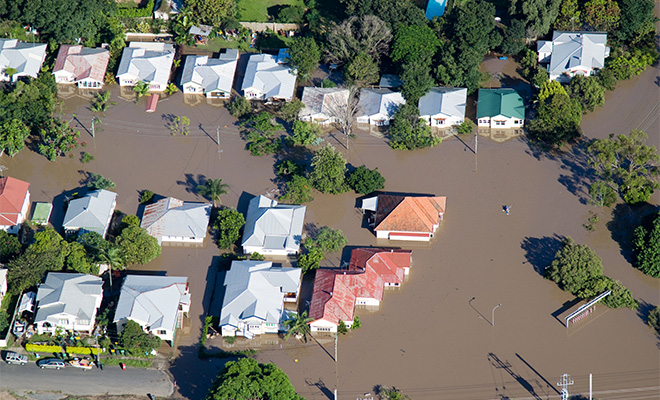How we can safeguard ourselves as climate change increases natural disasters
As climate change increases the frequency and impact of natural disasters, it’s important to recognise the threat these events, and their aftermath, will have on Australia’s economic growth, financial stability and way of life. With the cost of extreme weather event recovery efforts projected to match that of Australian Defence Force funding by 2050, the growth, scope and education of the emergency services industry and the leadership within has never been so crucial. The range of challenges the aftermath of natural disasters presents means the industry must see an increase in skills and capabilities of leaders and workers in all capacities if these events are to be navigated successfully.
Economic impact of climate change in Australia
A significant percentage of Australia’s population and economic activity is concentrated in areas of high to extreme risk of severe weather events. In fact, $326.6 billion of Australia’s annual GDP could be wiped out by tropical cyclones (IAG, 2016). Rising population figures, coupled with the growing percentage of high-risk areas around the country, will impact communities’ ability to manage an increase in natural disasters.
The Australian Business Roundtable for Disaster Resilience and Safer Communities projects the economic cost of natural disasters to rise from $13.2 billion in 2017 to $39.3 billion by 2050, with the tangible and intangible costs encompassing emergency responses and property damage, the effect on businesses and supply chains, and the impact on wellbeing and employment.
Queensland facing catastrophic projections
Imagine a flood so devastating it needed to be tracked by satellite. That’s what Queensland experienced in early 2019 as torrential rain devastated northern parts of the state, causing hundreds of millions of dollars of damage. The floods immediately followed a period of time where the state suffered a major drought, the outbreak of over 140 bushfires, an extreme heatwave and what was initially classified as a tropical cyclone.
Queensland has the largest total annual cost of natural disasters of any Australian state, a figure expected to increase from $6.2 billion in 2017 to $18.3 billion by 2050. The increasing frequency and unpredictability of natural disasters shows why we need to continue to build the readiness and strength of resilience in the communities most at risk.
Observations, research and data indicate natural disasters will continue to increase, with projected rises in global temperatures, global sea levels, the frequency of natural disasters, and the impact on Australian lives and the country’s economy.

Shift in focus from disaster prevention to readiness
The increasing frequency and severity of natural disasters makes the need for skills and strong leadership crucial. Leaders within emergency management must be the link between the industry, policy makers, communities and relevant private sectors.
For the emergency management industry, challenges include managing increased uncertainty, fluctuating community resilience and intersecting political and operational interests. Natural disasters also highlight weaknesses in both policy and community preparedness, with common clashes between levels of government undermining emergency-service efforts.
Tackling these challenges has never been more important as Australia’s focus shifts from trying to prevent these natural disasters to ensuring our at-risk communities are prepared for them and resilient after them.
Preparation, growth in capabilities and effective leadership key for future
The impact of climate change and the increase of natural disasters is inevitable, with grave effects on Australian lives, stability and the economy. The focus must be on preparing at-risk communities and establishing resilience within them, growing the capabilities of emergency management and the continuous development of strong, effective leadership. Leaders in emergency management may need to pursue further education to develop their capability to take charge when devastating events occur.
The Graduate Certificate in Emergency and Disaster Management through QUT Online provides students with the opportunity to create important change in their communities. Course material covers disaster management, planning, response and recovery, as well as effective leadership, crucial to the successful coordination of emergency services.




